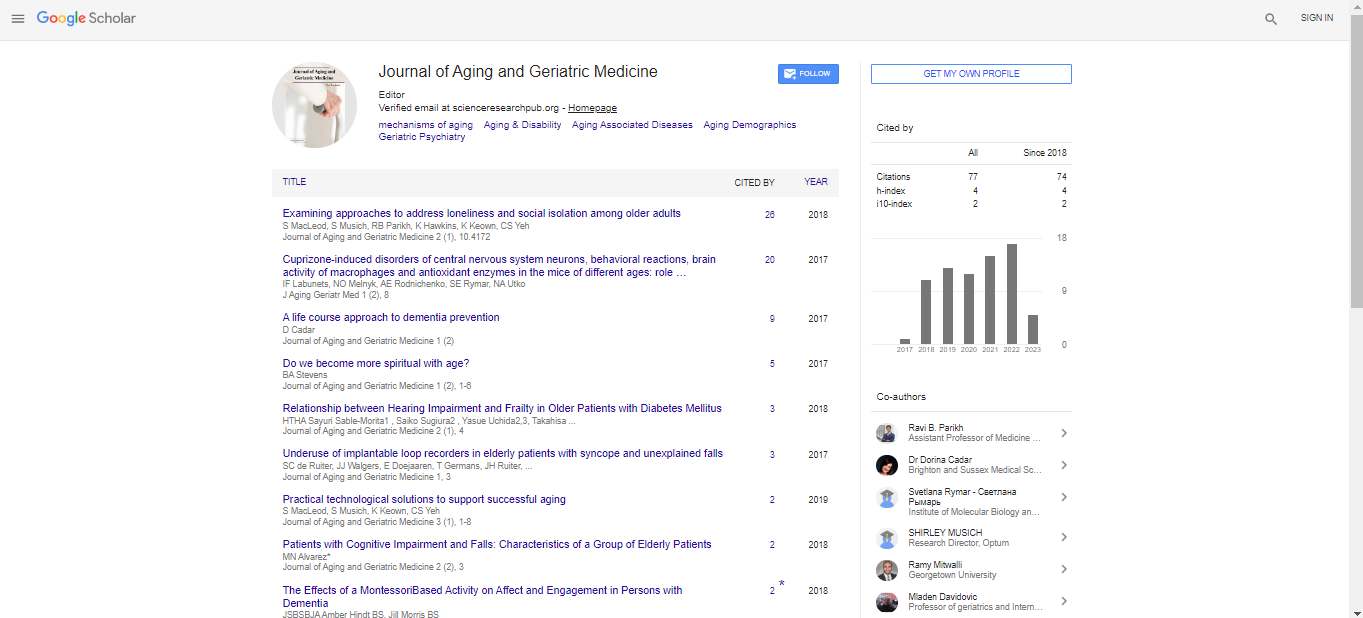Perspective, J Aging Geriatr Med Vol: 7 Issue: 3
Age-Defying Movement and Application of Physiotherapy for Geriatrics
Vasileios Hasset*
1Department of Biomedical and Neuromotor Sciences, University of Bologna, Bologna, Italy
*Corresponding Author: Vasileios Hasset,
Department of Biomedical and Neuromotor
Sciences, University of Bologna, Bologna, Italy
E-mail: vasileiosh@gmail.com
Received date: 21 April, 2023, Manuscript No. AGM-23-102358;
Editor assigned date: 24 April, 2023, PreQC No. AGM-23-102358 (PQ);
Reviewed date: 15 May, 2023, QC No. AGM-23-102358;
Revised date: 22 May, 2023, Manuscript No. AGM-23-102358 (R);
Published date: 29 May, 2023, DOI: 10.4172/2576-3946.1000162.
Citation: Hasset V (2023) Age-Defying Movement and Application of Physiotherapy for Geriatrics. J Aging Geriatr Med 7:3.
Abstract
Description
Physiotherapy focuses on promoting, restoring, and maintaining physical function, mobility, and overall well-being. This includes the assessment, diagnosis and treatment of various diseases, injuries and disorders affecting the musculoskeletal, nervous, cardiovascular and respiratory systems. Exercise may be the key for elderly people to maintain and regain the physical function needed for everyday functioning for elder people. A physiotherapist's prescribed exercise regimens can aid in easing joint mobility issues, improving coordination, and improving pulmonary function. Physiotherapy has advantages for elderly adults with chronic illnesses as well. Although physical therapy cannot reverse the effects of ageing on our bodies, it can assist to lessen such effects. Physiotherapists are skilled experts who are able to recognise the barriers that restrict elderly individuals from being independent and active.
The goal of physical therapy is to help people of all ages, including adults, optimize their physical function and independence. Physical therapists use a variety of evidence based techniques and interventions to achieve these goals. Therapy can help older adults struggling with the aging transition to take control of their emotions, find new sources of joy and meaning, and find new support systems. It helps people face their fear of death and deal with grief over the death of a friend or family member.
A comprehensive assessment is conducted for older adults to understand the individual's condition, medical history, physical abilities, and goals. This assessment may include physical examinations, movement analysis, and the use of specialized assessment tools. Based on the assessment findings, the physiotherapist will develop a personalized treatment plan tailored to the individual's needs. The plan may involve a combination of therapeutic exercises, manual therapy techniques, modalities (e.g., heat, cold, electrical stimulation) and other interventions.
Techniques of physiotherapy
Physiotherapy aims to reduce pain and discomfort experienced by adults. Techniques such as manual therapy, soft tissue mobilization, joint mobilization, and therapeutic modalities can help alleviate pain, improve joint mobility, and promote tissue healing. Physiotherapy focuses on improving functional abilities and mobility. Through exercises, stretching, strengthening, and balance training, physiotherapists work with adults to regain strength, flexibility, coordination, and balance required for daily activities.
Physiotherapy plays an important role for older adults in the rehabilitation and recovery process following injuries, surgeries, or medical conditions. Physiotherapists design rehabilitation programs to optimize healing, regain function, and facilitate a safe return to work, sports, or other activities. Physiotherapists educate older adults about their condition, provide strategies for self-management, and empower them to actively participate in their own recovery. This may include providing home exercise programs, ergonomic advice, and lifestyle modifications to promote long-term health and well-being.
Physiotherapists also work with older adults to prevent injuries, manage chronic conditions, and promote overall wellness. They provide guidance on exercise programs, ergonomics, posture, and healthy lifestyle choices to optimize physical health and prevent future problems.
Throughout the treatment process, physiotherapists closely monitor progress, adjust the treatment plan as needed, and provide ongoing support and guidance. They often collaborate with other healthcare professionals to ensure comprehensive care and achieve the best possible outcomes for older adults. Neurophysical therapy can treat a wide variety of conditions, both recent and chronic. Some neurological symptoms are progressive and worsen over time, requiring regular physical therapy and home exercise to maintain optimal health. Physiotherapy has been found to be effective in improving outcomes in terms of both pain and function in several musculoskeletal disorders. Randomized controlled trials show that manual therapy combined with exercise therapy under the supervision of a physiotherapist confers functional benefits in patients with knee osteoarthritis, delaying or preventing the need for surgery.
 Spanish
Spanish  Chinese
Chinese  Russian
Russian  German
German  French
French  Japanese
Japanese  Portuguese
Portuguese  Hindi
Hindi 